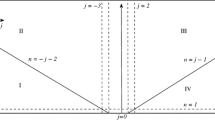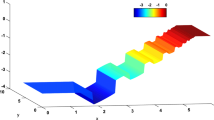Abstract
In this article we consider the initial value problem for a scalar conservation law in one space dimension with a spatially discontinuous flux. There may be infinitely many flux discontinuities, and the set of discontinuities may have accumulation points. Thus the existence of traces cannot be assumed. In Audusse and Perthame (Proc R Soc Edinb Sect A 135:253–265, 2005) proved a uniqueness result that does not require the existence of traces, using adapted entropies. We generalize the Godunov-type scheme of Adimurthi et al. (SIAM J Numer Anal 42(1):179–208, 2004) for this problem with the following assumptions on the flux function, (i) the flux is BV in the spatial variable and (ii) the critical point of the flux is BV as a function of the space variable. We prove that the Godunov approximations converge to an adapted entropy solution, thus providing an existence result, and extending the convergence result of Adimurthi, Jaffré and Gowda.
Similar content being viewed by others
References
Adimurthi, Ghoshal, S.S., Veerappa Gowda G.D: Existence and nonexistence of TV bounds for scalar conservation laws with discontinuous flux. Commun. Pure Appl. Math. 64(1), 84–115 (2011)
Adimurthi, Jaffré, J., Veerappa Gowda G.D: Godunov-type methods for conservation laws with a flux function discontinuous in space. SIAM J. Numer. Anal. 42(1), 179–208 (2004)
Adimurthi, Mishra, S., Veerappa Gowda G.D: Optimal entropy solutions for conservation laws with discontinuous flux functions. J. Hyperbolic Differ. Equ. 2, 783–837 (2005)
Andreianov, B., Cancès, C.: Vanishing capillarity solutions of Buckley-Leverett equation with gravity in two-rocks’ medium. Comput. Geosci. 17, 551–572 (2013)
Andreianov, B., Karlsen, K.H., Risebro, N.H.: A theory of \(L^1\)-dissipative solvers for scalar conservation laws with discontinuous flux. Arch. Ration. Mech. Anal. 201, 27–86 (2011)
Audusse, E., Perthame, B.: Uniqueness for scalar conservation laws with discontinuous flux via adapted entropies. Proc. R. Soc. Edinb. Sect. A 135, 253–265 (2005)
Baiti, P., Jenssen, H.K.: Well-posedness for a class of \(2\times 2\) conservation laws with \(L^{\infty }\) data. J. Differ. Equ. 140, 161–185 (1997)
Bürger, R., Karlsen, K.H., Risebro, N.H., Towers, J.D.: Well-posedness in \(BV_t\) and convergence of a difference scheme for continuous sedimentation in ideal clarifier-thickener units. Numer. Math. 97, 25–65 (2004)
Crandall, M.G., Majda, A.: Monotone difference approximations for scalar conservation laws. Math. Comput. 34, 1–21 (1980)
Diehl, S.: A conservation law with point source and discontinuous flux function modelling continuous sedimentation. SIAM J. Appl. Math. 56, 388–419 (1996)
Garavello, M., Natalini, R., Piccoli, B., Terracina, A.: Conservation laws with discontinuous flux. Netw. Heterog. Media 2, 159–179 (2007)
Ghoshal, S.S.: Optimal results on TV bounds for scalar conservation laws with discontinuous flux. J. Differ. Equ. 3, 980–1014 (2015)
Ghoshal, S.S.: BV regularity near the interface for nonuniform convex discontinuous flux. Netw. Heterog. Media 11, 331–348 (2016)
Holden, H., Risebro, N.H.: Front Tracking for Hyperbolic Conservation Laws. Springer, New York (2002)
Kružkov, S.N.: First order quasilinear equations with several independent variables. Mat. Sb. (N.S.) 81(123), 228–255 (1970). (Russian)
May, L., Shearer, M., Davis, K.: Scalar conservation laws with nonconstant coefficients with application to particle size segregation in granular flow. J. Nonlinear Sci. 20, 689–707 (2010)
Panov, E.Y.: Existence of strong traces for quasi-solutions of multidimensional scalar conservation laws. J. Hyperbolic Differ. Equ. 4, 729–770 (2007)
Panov, E.Y.: On existence and uniqueness of entropy solutions to the Cauchy problem for a conservation law with discontinuous flux. J. Hyperbolic Differ. Equ. 06, 525–548 (2009)
Piccoli, B., Tournus, M.: A general BV existence result for conservation laws with spatial heterogeneities. SIAM J. Math. Anal. 50, 2901–2927 (2018)
Shen, W.: On the uniqueness of vanishing viscosity solutions for Riemann problems for polymer flooding. Nonlinear Differ. Equ. Appl. 24, 37 (2017)
Towers, J.D.: Convergence of a difference scheme for conservation laws with a discontinuous flux. SIAM J. Numer. Anal. 38, 681–698 (2000)
Towers, J.D.: An existence result for conservation laws having BV spatial flux heterogeneities—without concavity. J. Differ. Equ. 269, 5754–5764 (2020)
Vasseur, A.: Strong traces of multidimensional scalar conservation laws. Arch. Ration. Mech. Anal. 160, 181–193 (2001)
Acknowledgements
First and second author acknowledge the support of the Department of Atomic Energy, Government of India, under Project No. 12-R&D-TFR-5.01-0520. First author would also like to thank Inspire faculty-research Grant DST/INSPIRE/04/2016/000237. We thank two anonymous referees for their careful reading of the paper, and for their helpful comments.
Author information
Authors and Affiliations
Corresponding author
Additional information
Publisher's Note
Springer Nature remains neutral with regard to jurisdictional claims in published maps and institutional affiliations.
Appendix
Appendix
Let \(g:\mathbb {R}\rightarrow \mathbb {R}\) be defined as \(g(x)=\left| x\right| \). Suppose u satisfies entropy condition (12) then set \(v(x,t)=\Psi (u(x,t),x)\) where \(\Psi \) is as in (10). We denote inverse of the map \(\zeta \mapsto \Psi (\zeta ,x)\) by \(\alpha (\cdot ,x)\). Then we have
for any \(k\in \mathbb {R}\) and \(0\le \phi \in C_0^{\infty }(\mathbb {R}\times \mathbb {R}_+)\).
Lemma 5.1
[18] Let \(v_1,v_2\in L^{\infty }(\mathbb {R}\times \mathbb {R}_+)\) be two functions satisfying (93). Then we have
Proof
For \(0\le \phi \in C_c^{\infty }(\mathbb {R}_+\times \mathbb {R})\) and \(0\le \psi \in C_c^{\infty }(\mathbb {R}_+\times \mathbb {R})\) we have
and
Fix a \(\Phi \in C_c^{\infty }(\mathbb {R}\times \mathbb {R}_+)\). Let \(\eta _\epsilon \) be Friedrichs mollifiers. Consider
Putting \(k=v_2(y,s)\) and \(l=v_1(x,t)\) in (95) and (96) respectively and adding the resultants we get
where
Let \(E_0,E_1,E_2\subset \mathbb {R}\) be three sets such that
where \(r=\max \{\Vert v_1\Vert _{L^{\infty }(\mathbb {R}\times \mathbb {R}_+)},\Vert v_2\Vert _{L^\infty (\mathbb {R}\times \mathbb {R}_+)}\}\). Since \(v_2\in L^{\infty }(\mathbb {R}\times \mathbb {R}_+)\), \(E_0,E_1\) are measurable sets and \(meas(\mathbb {R}_+\setminus E_0)=meas(\mathbb {R}\setminus E_1)=0\). By our assumption, for a fixed \(x\in \mathbb {R}\), \(\Psi (x,\cdot )\) is Lipschitz on \([-r,r]\). Since \(C([-r,r])\) is separable, by Pettis Theorem we have measurability of \(E_2\) and \(meas(\mathbb {R}\setminus E_2)=0\). Therefore we can get
as \(\epsilon \rightarrow 0\) for \(x\in E_1\) and a.e. \(t,s\in \mathbb {R}_+\). We can also obtain
as \(\epsilon \rightarrow 0\) for \(x\in E_2\) and a.e. \(t,s\in \mathbb {R}_+\). With the help of (103) and (104) and Lebesgue Dominated Convergence Theorem we have
In a similar way we can show
Similarly we have
as \(\epsilon \rightarrow 0\) for \(x\in E_1\) and a.e. \(t,s\in \mathbb {R}_+\). Then by Lebesgue Dominated Convergence Theorem we have
We also have for a.e. \(x\in \mathbb {R}\) and \(t\in E_0\)
as \(\delta \rightarrow 0\). This yields
This completes the proof. \(\square \)
Observe the following
From Lemma 5.1 we can prove the following by a similar argument as in [15].
Lemma 5.2
Let \(v_1,v_2\in C([0,T],L^{1}_{loc}(\mathbb {R}))\cap L^{\infty }(\mathbb {R}\times \mathbb {R}_+)\) be two function satisfying (93). Then for a.e. \(t\in [0,T]\) and any \(r>0\) we have
swhere \(L_1:=\sup \{\partial _u A(u,x);\,x\in \mathbb {R},\left| u\right| \le \max (\Vert v_1(x,0)\Vert _{L^{\infty }},\Vert v_2(x,0)\Vert _{L^{\infty }})\}\).
Rights and permissions
About this article
Cite this article
Ghoshal, S.S., Jana, A. & Towers, J.D. Convergence of a Godunov scheme to an Audusse–Perthame adapted entropy solution for conservation laws with BV spatial flux. Numer. Math. 146, 629–659 (2020). https://doi.org/10.1007/s00211-020-01150-y
Received:
Revised:
Accepted:
Published:
Issue Date:
DOI: https://doi.org/10.1007/s00211-020-01150-y




